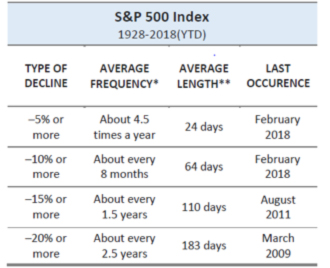COMMENTARY AND PERSPECTIVE ON US MARKETS
So, the market commentary we sent out last week mentioned that several market indicators gave us pause that a long overdue correction might be in the offing. Lo and behold, it seems it might be here much sooner than everyone thought. (If you didn’t take the time to read our Commentary last week, here’s the link: Is It Fall Yet?
Before you give us credit for our clairvoyance, let us assure you we do not have a crystal ball. No one does. What we’ll attempt to do here in this extra special in-between-the-quarters-message, is to provide some valuable insight to help you make sense of it all and to find some even more valuable perspective. First, let’s make sense of it all.
Everyone would love a short, concise explanation with total accuracy as to why stock markets have behaved the way they have over the past few days. A simple, logical, description of what’s happening and why and – more importantly – what’s going to happen next. The answers are so obvious, right? Sorry – but that’s not the way this works. It’s much easier for the media to convince you of the reasons for what has happened than persuade you about what will happen in the future.
This market downdraft might be due to the Fed raising interest rates. Except we’ve known about the Fed’s intention to raise rates for months. Perhaps we can blame the elevated stock valuations in the US compared to the rest of the world. But, overseas markets have fallen for the past few days too. Maybe it’s the trade war that the President has started. That saber has been rattling for months. The politically obsessed suggest it’s the upcoming mid-term elections and the pending takeover of the House by the Democrats. But nothing’s really changed in the electoral outlook.
The simple truth (as we’ve said for 30 years and counting) is that the future short-term direction of things is fundamentally unknowable. That’s why you stay diversified, even when it’s unpopular.
Now, for a little perspective:
As of this writing on Friday, this market panic/correction/bear market is the worst decline we’ve experienced since – get ready for it – February of 2018. Markets have pulled back to levels we haven’t witnessed since…July of this year. Thursday’s decline left the S&P 500 about 7% below it’s all time high, which it set in September. (Read this last paragraph again and take a deep breath.)
This is not to suggest things won’t get messier for stocks in the short term. They might. No one really knows. Since 2009, US large stocks have tripled during their longest expansion on record. 2017 saw virtually every investment class produce handsome returns with no volatility at all. Contrast this with the following historical perspective:
On average, US stocks experience an annual temporary decline of -10% to -14% sometime during the year. Every four to five years, US stocks decline by an average of about 30%. These declines have also been temporary. And yet, through all this mayhem, US stocks have still delivered around 9% average annual returns for the past 90 years or so* for those who remain steadfast and refused to bow to hindsight commentary and panic out. Here’s a handy chart on past declines and recovery periods:

You’ll note that market declines are more frequent than you probably remember. You can thank your “Recency Bias” for that. (Recency bias means that people generally expect the future to look like the recent past, and they are surprised when it doesn’t.) Markets have been relatively calm since late 2016, so this type of market activity is really more “normal” than people recall.
Another bit of perspective: Remember that the comebacks are always stronger than the setbacks. Yes, it’s nerve wracking when markets act up. But sooner or later it ends, and things start the inevitable march back upward. The percentage of time the US stock market has declined and then recovered to new highs is exactly 100%. If anything, this should cause rational investors to consider adding to their holdings when markets sell off rather than running for the exits.
Finally, some economic perspective. The US economy continues to expand. Companies will begin reporting 3rd quarter earnings today, and they are expected to be robust. It’s hard to make the case for a bear market when unemployment is at historic lows, wage growth is increasing, inflation is less than 2.5% and economic activity is bustling.
None of this should be taken to mean that we do not expect a normal correction in stocks at some point. We are certainly overdue for one. We’re just not sure this is it. But it certainly should remind investors that market corrections are perfectly normal. You’ve been experiencing them all your investing life.
The bottom line to all this is – if you own a globally diversified portfolio, you don’t just own US stocks. You own everything. And if you own everything, you don’t necessarily make a killing in good times, but you don’t get killed in bad times either. You can neither control nor predict the US markets short term behavior. Your sword and your shield are a properly diversified portfolio that’s prepared for any outcome over the long term. Because the long term is all that matters. Everything else is just noise.
Don’t hesitate to call us if you have any questions or concerns at all. We’re here to answer your questions.
The First Coast Wealth Advisors Team
*Source: CNBC
